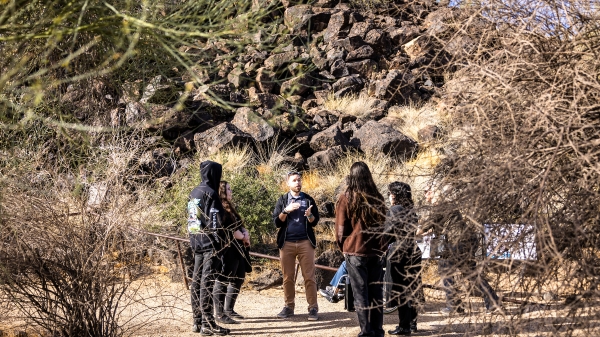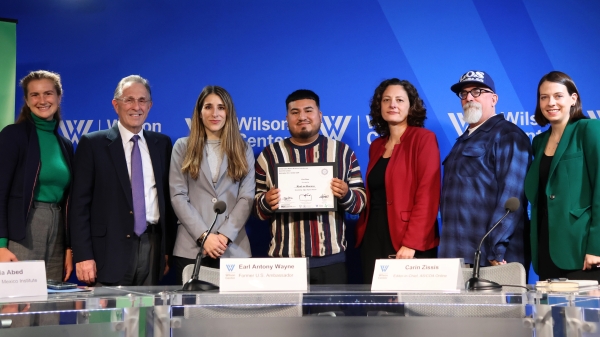ASU professor’s award-winning book allows her to launch scholarship for children of female shrimp traders in Mexico

Maria Cruz-Torres, associate professor at the School of Transborder Studies at ASU, poses for a portrait at MRSC Studios at ASU Tempe. Photo by Samantha Chow/ASU
When Arizona State University Associate Professor Maria Cruz-Torres set out to conduct the fieldwork for her third book, "Pink Gold," more than 16 years ago, she didn’t count on having major surgery and losing both her parents along the way.
But the labor of love continued, and the book — about the challenges faced by the "shrimp ladies" in southern Sinaloa, Mexico, who sell seafood in open-air markets, forming an extralegal but key part of the economy, and face down conflicts from authorities and the military — is fittingly dedicated to her mother, who Cruz-Torres says showed her the value of hard work and determination.
Cruz-Torres, part of the School of Transborder Studies at ASU, was just named the winner of the Arthur J. Rubel Book Prize by the Society for Latin American and Caribbean Anthropology. The award comes with a $1,000 prize, which she will use to create a scholarship for the children of the women she got to know during her time at fisheries in Sinaloa, Mexico.
Some of those women and children are no longer alive due to the notorious drug cartel activity in the region, but their memory lives on. Cruz-Torres is determined to share the intricate details surrounding the hardworking, family-oriented Mexican women who support their families by fishing for shrimp and who break traditional gender roles by becoming heads of households.
Cruz-Torres also received an honorable mention for the Sara A. Whaley Book Prize by the National Women’s Studies Association. She traveled to Michigan and Florida to receive both awards at their respective annual conferences over the past several weeks.
ASU News had the opportunity to discuss the book and awards with the author.
Question: What does it mean to you to be honored like this for your work?
Answer: I’m very happy that this work has been recognized nationally and that the lives and struggles of the women in the book are now part of a historical narrative. It has been my life.
Q: Why was it important for you to set up a scholarship for them with the money you were awarded?
A: I wanted to help the daughters and granddaughters of seafood traders so they can help their children and grandchildren. I am in the process of identifying three students, and it will be good to support them with books or whatever they need for school.
Q: How did you become interested in female shrimp farmers in Mexico?
A: I had heard stories and was doing research for my doctoral dissertation at Rutgers. I read articles that portrayed these women as aggressive and defensive when I met a woman and she invited me to Mazatlán to see the work being done in this mostly male-dominated industry. I wanted to learn more about Latin American fisheries and explore how the gender role had evolved. Their world was invisible and needed more historical research, and no one had conducted research on this topic.
Q: What did you discover about these nontraditional women?
A: There was no information about them, and as I looked through old newspapers in Mazatlán, I was trying to reconstruct history to see how they had developed — essentially from nothing to an organized all-women labor union. They were born out of necessity because there were no permanent jobs available to them to help them support their families. They are now icons in their own right and have even become somewhat of a landmark to see along the freeway, otherwise known as carretera libre, which runs from Mazatlán to Culiacán on the western side of Mexico.
Q: How did the men react to women taking on this profession that was once solely reserved for them?
A: Many of the women had male family members in the industry and had some support. Some men would even give them fish to sell, but they were also competition. One even wrote a letter to Mexican President Carlos Salinas de Gortari blaming them for taking their jobs. They were seen as a threat until recently. They had to sell at lower prices to compete for business. Most of the authorities in the area were male, so they were not supportive. They didn’t see them as real working people. Authorities received dozens of complaints.
Now, they did have some support from students. They were growing up and becoming business owners and customers and lent their support to help them form a legal workers union. Eventually, they were able to become street vendors, but they really fought to get that space.
Q: Did you ever feel like your life might be in danger due to the high cartel activity in the area?
A: I never felt that my life was in danger, but I had to be very well aware of my context and the kind of precautions that I needed to take. Some of the women I met had family members lost to the cartels. In 2009–2011, a child was kidnapped from the marketplace. I felt very sad, as well as surprised, because of the unpredictability of the event. It was particularly disturbing because I had known him since he was a little boy helping his mother at the market. As a mother, I felt her anguish and still do.
Q: What was your relationship like with these women who essentially let you into their lives?
A: I became really close to some of them. Little by little, I earned their trust, or confianza. They invited me into their homes to meet their families, and I had to develop that confianza. I was even invited to family gatherings like a quinceañera, which is a traditional Mexican coming-of-age party for a 15-year-old girl. Most of the women have now retired, some of them died during the COVID pandemic. Some of the children I met are now grown women themselves and have carried on the fishing traditions that their mothers taught them.
Q: What does the future look like for the new generation of fisherwomen?
A: There has been a lot of changes. The preference is for their children to get an education, and several have already done so. Some of the kids have gone on to university and become nutritionists, bankers, you name it. Several have come back to help their mothers.
More Arts, humanities and education

Petroglyph preserve celebrates 30th anniversary with ancient, modern tales
The Deer Valley Petroglyph Preserve provides a beautiful walk through a pristine desert where chuckwalla lizards are as plentiful as the cacti that comes in many shapes and sizes.It’s also a step…

Kaleidoscope short film contest inspires powerful binational filmmaking in its second year
“We come to this country not to steal anybody’s jobs but to take advantage of the opportunities that the rest ignore. We’ve been taking care of the American soil for many years. But our hands will…

ASU's Neal Lester reflects on life, death of poet Nikki Giovanni
When Neal Lester heard on Monday that poet and activist Nikki Giovanni had died, the news hit hard.Lester, the founding director of Arizona State University’s Project Humanities and a Foundation…




